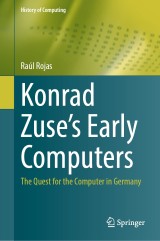Details

Konrad Zuse's Early Computers
The Quest for the Computer in GermanyHistory of Computing
|
37,44 € |
|
| Verlag: | Springer |
| Format: | |
| Veröffentl.: | 13.10.2023 |
| ISBN/EAN: | 9783031398766 |
| Sprache: | englisch |
Dieses eBook enthält ein Wasserzeichen.
Beschreibungen
<p>This book describes the historical development of the architectures of the first computers built by the German inventor Konrad Zuse in Berlin between 1936 and 1945. Zuse's machines are historically important because they anticipated many features of modern computers.</p>
Specifically, these include the separation of processor and memory, the ability to compute with floating-point numbers, a hardware architecture based on microprogramming of the instruction set, and a layered design with a high-level programming language on top. In fact, Zuse's early computers are closer to modern computers than the Harvard Mark I or ENIAC, two other contenders for the title of "world's first computer." The theoretical program first conceived by Zuse in 1936/37 was fulfilled with a series of machines built before and during World War II: the Z1, Z2, Z3, and Z4. Separate chapters deal with the architecture of each computer, culminating in the description of Plankalkül, the first proposal for a high-level programming language.<br><p></p>
<p>Students of the sciences and practitioners of computer science should have no trouble following the material. The concise introductory summary sets the reader on the historical path to retrace this remarkable intellectual adventure.</p><p></p>
Specifically, these include the separation of processor and memory, the ability to compute with floating-point numbers, a hardware architecture based on microprogramming of the instruction set, and a layered design with a high-level programming language on top. In fact, Zuse's early computers are closer to modern computers than the Harvard Mark I or ENIAC, two other contenders for the title of "world's first computer." The theoretical program first conceived by Zuse in 1936/37 was fulfilled with a series of machines built before and during World War II: the Z1, Z2, Z3, and Z4. Separate chapters deal with the architecture of each computer, culminating in the description of Plankalkül, the first proposal for a high-level programming language.<br><p></p>
<p>Students of the sciences and practitioners of computer science should have no trouble following the material. The concise introductory summary sets the reader on the historical path to retrace this remarkable intellectual adventure.</p><p></p>
<p>1. Konrad Zuse and the Dawn of the Computer Age.- 2. The Race to Build the Computer in World War II.- 3. The Z1: Architecture and Algorithms of Zuse’s First Computer.- 4. The Z2 and the Cipher Machine.- 5. The Architecture of the Z3.- 6. How to Make Zuse’s Z3 a Universal Computer.- 7. The S1 and S2: Zuse’s Work for the German Military 1941-1945.- 8. The Architecture of the Z4.- 9. The Conditional Jump: Making the Z4 Universal.- 10. Plankalkül.- 11. Zuse’s Computer for Binary Logic.- 12. The First Code for Computer Chess.- 13. The Reconstruction of Konrad Zuse’s Z3.- 14. Epilogue.</p><p></p>
<p>Raul Rojas is Professor of Mathematics and Statistics at the University of Nevada, Reno. He was Professor of Artificial Intelligence at the Freie Universität Berlin from 1997 to 2020. Previously, he held professorships at the Martin Luther University Halle-Wittenberg and the Technical University of Vienna. Raul Rojas' field of research is the theory and applications of artificial intelligence algorithms. He has published two books on neural networks with Springer-Verlag, as well as the book “Die Rechenmaschinen von Konrad Zuse” (1998), a volume that finds its continuation in this new book. Prof. Rojas is a member of the Mexican Academy of Sciences, received the National Science Prize of Mexico in 2015, and was named Professor of the Year in Germany in 2014.<br></p>
This book describes the historical development of the architectures of the first computers built by the German inventor Konrad Zuse in Berlin between 1936 and 1945. Zuse's machines are historically important because they anticipated many features of modern computers.<div><div>Specifically, these include the separation of processor and memory, the ability to compute with floating-point numbers, a hardware architecture based on microprogramming of the instruction set, and a layered design with a high-level programming language on top. In fact, Zuse's early computers are closer to modern computers than the Harvard Mark I or ENIAC, two other contenders for the title of "world's first computer." The theoretical program first conceived by Zuse in 1936/37 was fulfilled with a series of machines built before and during World War II: the Z1, Z2, Z3, and Z4. Separate chapters deal with the architecture of each computer, culminating in the description of Plankalkül, the first proposal for a high-level programming language.</div><div>Students of the sciences and practitioners of computer science should have no trouble following the material. The concise introductory summary sets the reader on the historical path to retrace this remarkable intellectual adventure.<p><b>Raul Rojas</b> is Professor of Mathematics and Statistics at the University of Nevada, Reno, US. He is also Professor Emeritus at Freie Universität Berlin. He has published two books on neural networks with Springer-Verlag, as well as the book “Die Rechenmaschinen von Konrad Zuse,”a volume that finds its continuation in this new book. Prof. Rojas was named Professor of the Year in Germany in 2014.</p></div></div>
First in-depth exploration of Zuse's contribution Definitive reference on all of Zuse's early machines Covers all machines designed and built from 1936 to 1945 (Z1,Z2,Z3,Z4)
Diese Produkte könnten Sie auch interessieren:

From Combinatorics to Philosophy

von: Ernesto Damiani, Ottavio D'Antona, Vincenzo Marra, Fabrizio Palombi

149,79 €















